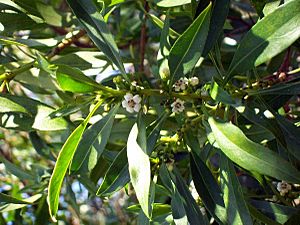Pointed boobialla facts for kids
Quick facts for kids Pointed boobialla |
|
|---|---|
 |
|
| Myoporum acuminatum in the Batemans Bay botanic garden | |
| Scientific classification | |
| Genus: |
Myoporum
|
| Species: |
acuminatum
|
Myoporum acuminatum, also called waterbush, pointed boobialla, or mangrove boobialla, is a flowering plant. It belongs to the figwort family called Scrophulariaceae. This plant is special because it only grows in eastern Australia.
You can find Myoporum acuminatum in rainforests or wet eucalyptus forests. It usually grows near the coast and in the Coastal Ranges. Sometimes, it even grows near mangroves. You might also spot it in drier rainforest areas. This plant grows naturally from Mimosa Rocks National Park in southern New South Wales all the way north to Fraser Island in southern Queensland.
Contents
What Does Myoporum acuminatum Look Like?
Myoporum acuminatum is a plant that can be a shrub or a small tree. It doesn't have any hairs on its stems or leaves. It can grow up to 13 metres (about 40 feet) tall. The trunk can be as wide as 50 centimetres (about 20 inches).
Older plants might have an uneven trunk with parts that stick out. The bark is usually greyish-brown and looks a bit wrinkled on bigger trees. The small branches are green and smooth, and they are quite thick.
Some people used to think M. acuminatum was the same as another plant called Myoporum montanum. These two plants are very similar and grow in some of the same places. The name "Waterbush" first came from M. montanum. This plant grows in dry central Australia as well as coastal areas. Finding M. montanum often means there is water underground.
It can be tricky to tell these two plants apart. But here are some clues:
- M. montanum has smaller, thinner leaves.
- The sepals (leaf-like parts protecting the flower bud) of M. montanum don't have clear edges like M. acuminatum.
- The fruit of M. montanum is pink or light purple. The fruit of M. acuminatum is dark purple or blue.
Leaves
The leaves of Myoporum acuminatum are usually 5 to 14 centimetres long. They are 7 to 28 millimetres wide. Most leaves have a fine point at the end, but sometimes they can have a rounded tip.
The bottom of the leaf gets thinner near the leaf stem, which is 6 to 20 millimetres long. The edges of the leaves can be slightly toothed or completely smooth. These leaves do not have stipules (small leaf-like parts at the base of the leaf stem).
If you look closely with a magnifying glass, you might see tiny oil dots on the leaves. Only the main vein in the middle of the leaf is easy to see. Other smaller veins are hard to spot.
Flowers and Fruit
The flowers of Myoporum acuminatum usually appear from May to August. In the southern parts of Australia, they might bloom a bit later. The flowers have five white petals. They also have four rows of purple spots and smell sweet.
These flowers grow in groups from where the leaves meet the stem. This spot is called the leaf axils.
The fruit is a round, wrinkled drupe. It is about 5 millimetres wide and is dark blue or dark purple. You can see the remains of the flower's style (the part that receives pollen) sticking out of the fruit. This part is 3 to 4 millimetres long and looks like a hook. Inside the fruit, there are two to four seeds. The fruits ripen from October to February.
How Myoporum acuminatum Got Its Name
The plant was first described in a science book called Prodromus Florae Novae Hollandiae in 1810. The person who wrote about it was Robert Brown.
The name of the plant group, Myoporum, comes from two Ancient Greek words. Myein means "to shut" or "to close." Poros means "opening" or "pore." This name refers to the tiny glands on the leaves, flowers, and fruits that look like clear spots.
The second part of the name, acuminatum, is a Latin word. It means "tapering to a prolonged point." This describes the pointed shape of the leaves.
Where Myoporum acuminatum Grows
Myoporum acuminatum grows in rainforests or eucalyptus forests. You can find it in eastern Australia, from Queensland down to the far south coast of New South Wales.
Growing Myoporum acuminatum in Gardens
The waterbush is a strong plant that is easy to grow in gardens. It can even handle salty air near the coast. It likes soil that drains well and needs lots of sunshine. The easiest way to grow new plants is by taking cuttings from an existing plant.

